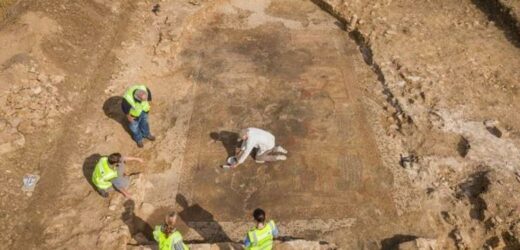Archaeologists 'stunned' at discovery of Roman settlement
We use your sign-up to provide content in ways you’ve consented to and to improve our understanding of you. This may include adverts from us and 3rd parties based on our understanding. You can unsubscribe at any time. More info
The rare piece was found in a Roman villa beneath a farmer’s field in Rutland and has been protected by the Department for Digital, Culture, Media and Sport (DCMS) on the advice of Historic England. It is the only UK find of its kind, displaying stunning scenes from Homer’s The Iliad, and is one of only a handful from across the whole of Europe. The remains of the mosaic measure 11metres by almost 7metres and depict part of the story of the Greek hero Achilles.
The artwork forms the floor of what’s thought to be a large dining or entertaining area.
The landowner’s son, Jim Irvine, was the first to stumble upon the site, an elaborate villa complex that contained the spectacular mosaic.
Mr Irvine said: “A ramble through the fields with the family turned into an incredible discovery.
“Finding some unusual pottery amongst the wheat piqued my interest and prompted some further investigative work. Later, looking at the satellite imagery I spotted a very clear crop mark, as if someone had drawn on my computer screen with a piece of chalk.
“This really was the ‘oh wow’ moment, and the beginning of the story.”


The site was later investigated by archaeologists from the University of Leicester, who worked in partnership with Historic England.
Historic England was then able to secure funding for urgent archaeological investigations of the site by ULAS in August 2020.
Further excavation involving staff and students from the University o Leicester’s School of Archaeology and Ancient History examined more of the site in September 2021.
Mosaics were used in number of different kinds of private and public buildings across the Roman Empire, and commonly featured famous figures from history and mythology.

But this Rutland mosaic is unique because it features Achilles and his battle with Hector at the end of the Trojan War.
The room is part of a large villa building that was thought to have been occupied in the late Roman period, between the 3rd and 4th century AD.
The villa is also surrounded by a number of other buildings and features revealed by a geophysical survey and archaeological evaluation, including what look like aisled barns, circular structures and a possible bath house, all within a series of boundary ditches.
Researchers think the villa was occupied by a wealthy individual, with a knowledge of classical literature.
DON’T MISS
Stonehenge breakthrough: New tests uncover Neolithic secret [REVEAL]
‘Ship swallower’ off British coast has claimed ‘50,000 lives’ [INSIGHT]
Man discovered more valuable rock than gold [REPORT]


And fire damage and breaks in the mosaic could indicate that the site was later re-used and re-purposed.
John Thomas, Deputy Director of ULAS and project manager on the excavations, said: “This is certainly the most exciting Roman mosaic discovery in the UK in the last Century.
“It gives us fresh perspectives on the attitudes of people at the time, their links to classical literature, and it also tells us an enormous amount about the individual who commissioned this piece.
“This is someone with a knowledge of the classics, who had the money to commission a piece of such detail, and it’s the very first depiction of these stories that we’ve ever found in Britain.”
Source: Read Full Article

